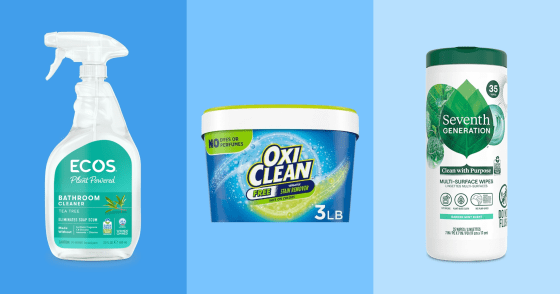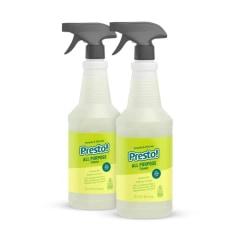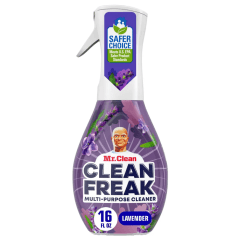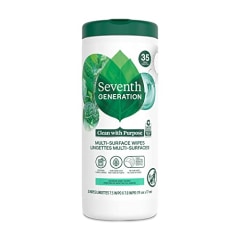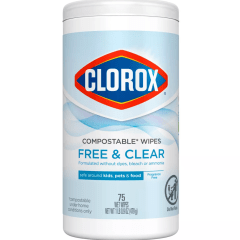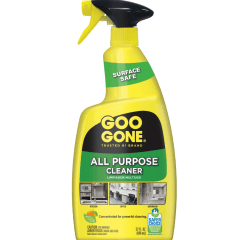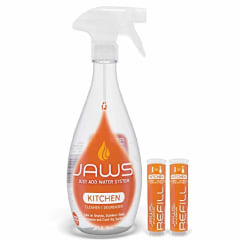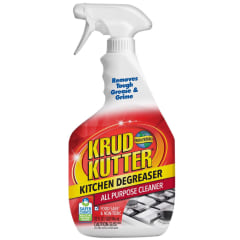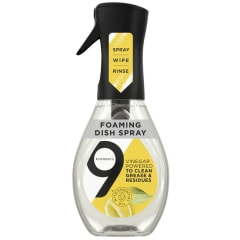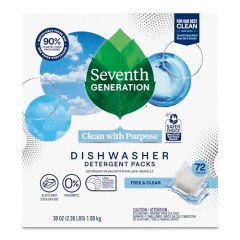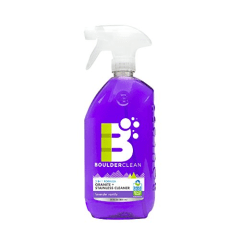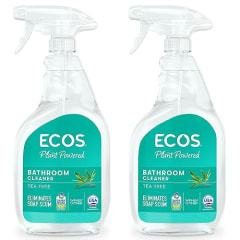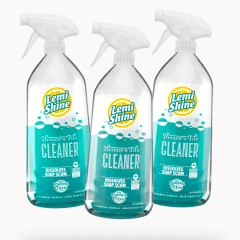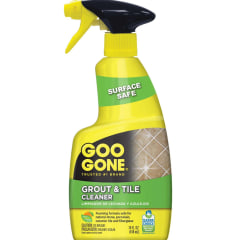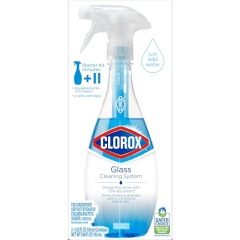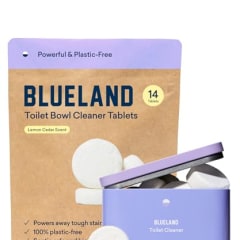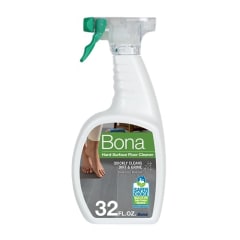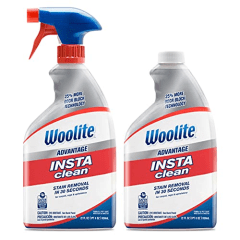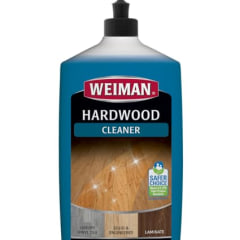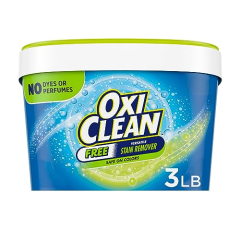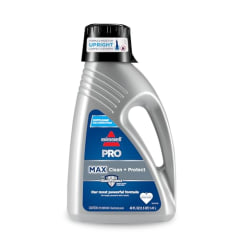“Eco-friendly,” “green” and “natural” — you’ve likely seen these words a lot. But what do these terms mean? In some cases, nothing at all. Companies have to meet no specific criteria before slapping “eco-friendly” on their packaging, says Nancy Simcox, an assistant teaching professor at the University of Washington’s Department of Environmental and Occupational Health Sciences. This poses a problem for shoppers — it’s hard to know whether products are designed with their environmental impact in mind or if a company is just cashing in on the sustainability movement.
Thankfully, you can take a few steps to determine whether cleaning products are eco-friendly, like looking for those certified by the U.S. Environmental Protection Agency’s Safer Choice Standard. Using expert guidance, we rounded up the best EPA-approved eco-friendly cleaning products and broke down how to make your own at home with ingredients you probably have in your pantry.
SKIP AHEAD All-purpose cleaners | Kitchen cleaners | Bathroom cleaners | Floor cleaners | How to make your own cleaning products at home
How we picked the best eco-friendly cleaning products
When brands label their products eco-friendly, green, or natural without defining what these terms actually mean or providing evidence for sustainability claims, they’re engaging in greenwashing, says Simcox. Shoppers don’t often question the significance of these labels, but if they did, they would learn that definitions vary by brand and even by product, she says.
To avoid buying greenwashed cleaning products, experts recommend looking for those with ecolabel certifications. According to the EPA, ecolabels are “marks placed on product packaging that help consumers identify products that meet specific environmental performance criteria and are therefore deemed ‘environmentally preferable.” Experts say ecolabels are the best way to ensure products are designed to be safe for the environment to some degree.
Many eco-labels exist, including those run by Green Seal, Ecologo, Cradle to Cradle and the Environmental Working Group. But our experts consider the EPA to be the gold standard.
The EPA runs two ecolabel programs for cleaning products: Safer Choice for everyday cleaners and Design for the Environment for antimicrobial products like disinfectants. Both programs “evaluate product performance and assess their ingredients to make sure they meet environmental and human health and safety criteria,” according to the EPA. The agency says it regularly audits brands with its ecolabels to verify that standards are being upheld over time. Shoppers can browse through online databases listing products that have each ecolabel.
A key component of the EPA’s ecolabels is brand transparency about ingredients, says Anna Reade, a senior scientist for the Natural Resources Defense Council (NRDC), a nonprofit environmental advocacy group. Products that meet the EPA’s standards and earn an ecolabel are required to list all of their ingredients, which is not required by law nationwide. Products also have to be packaged sustainably, such as in recycled plastic.
The best all-purpose eco-friendly cleaning products
“Having a versatile cleaning toolkit is essential,” says Marla Mock, president of Molly Maid, a Neighborly company that offers residential and commercial cleaning services. In its most basic form, your cleaning kit should include products for general maintenance, like all-purpose sprays and wipes, and a gentle abrasive for areas that need a good scrub. Keeping microfiber towels at home is a great sustainable alternative to single-use paper towels, and a steam cleaner can be your best friend when sanitizing surfaces or removing dirt from nooks and crannies, says Mock.
Below are some of our favorite all-purpose eco-friendly cleaning products certified by the EPA’s Safer Choice Standard. We excluded laundry care products from this list, but if you’re interested, check out our guide to eco-friendly laundry detergents. We also excluded disinfectants and thus products with the EPA’s Design for the Environment ecolabel. Experts say you don’t need to use disinfectants during everyday home cleaning — rather, they’re used situationally, like when someone is sick.
The best eco-friendly cleaning products for the kitchen
The more you cook, the faster your kitchen tends to get dirty. But as long as you wipe down your counters and wash your dishes daily, as well as take out the trash as needed, you can clean your floors, windows and appliances once a week, says Angie Hicks, co-founder of Angi, a network of home service providers. However, if you splatter tomato sauce on your stovetop or spill something inside your microwave, clean it up immediately to avoid stains and attracting pests. Below are some of our favorite eco-friendly kitchen cleaners, all certified by the EPA’s Safer Choice Standard.
The best eco-friendly cleaning products for the bathroom
You can clean most areas of the bathroom weekly, but be sure to wipe down your sink and countertops more frequently since they tend to see the most splashes and splatters, says Hicks. Glass surfaces like shower doors, windows and mirrors are prone to hard-water and mold buildup if they’re not properly cared for, so cleaning these areas weekly is something you shouldn’t skip, says Jeramy Sibley, president of Glass Doctor, a glass repair, replacement and installation company. Also consider keeping a reusable squeegee in your shower to dry the walls, doors and floors after each use, he says. Below are some of our favorite eco-friendly bathroom cleaners, all certified by the EPA’s Safer Choice Standard.
The best eco-friendly cleaning products for floors
As a rule of thumb, experts recommend cleaning floors in high-traffic areas once a week and cleaning floors in low-traffic areas every two weeks. You can mop hard floors like hardwood, vinyl and tile with a compatible cleaning solution and use a carpet cleaner for rugs. Plus, be sure to vacuum all floors as needed. It’s also a good idea to keep a stain remover for carpets and upholstery at home in case of accidents that result from spills, pets or kids. Below are some of our favorite eco-friendly floor cleaners, all of which are certified by the EPA’s Safer Choice Standard.
How to make your own cleaning products at home
You can make eco-friendly cleaning solutions at home, but they will only work for some things, says Reade. “Homemade cleaning solutions do a really great job of cleaning your home, especially for low-touch or low-traffic areas. But when you should use them depends on what the job is,” she says. “If you’re concerned about disinfecting or sanitizing a surface, I would stick to products on the EPA’s Design for the Environment list.”
You probably have many ingredients you’ll need to make your own eco-friendly cleaning products in your pantry right now. Staples include baking soda, vinegar, dish soap, salt, rubbing alcohol, lemons and oranges, says Hicks. Here’s how to make an all-purpose cleaner, tile floor cleaner and more.
- All-purpose cleaner: Mix one part distilled white vinegar and one part water together. Pour the solution into a spray bottle. You can also add lemon or orange peel to naturally fragrance the spray, says Hicks.
- Bathroom cleaner: Combine 1 1/2 cups baking soda, 1/2 cup warm water, 1/2 cup liquid dish soap, two tablespoons of white vinegar and a squeeze of fresh lemon juice in a jar. Apply the cleaner to surfaces and scrub them with a sponge or wipe them down with a microfiber cloth, says Hicks.
- Carpet and upholstery cleaner: Remove odors by sprinkling baking soda over the area you want to clean and letting it sit for a few hours. Then vacuum it up, says Hicks. Note that using your vacuum to clean up ingredients made of fine powders like baking soda could harm the appliance, so read its instruction manual beforehand.
- Tile floor cleaner: Mix one cup of distilled white vinegar into a bucket of warm water. Use this solution to clean floors with a mop.
- Glass cleaner: Mix water, rubbing alcohol and distilled white vinegar together. Pour the solution into a spray bottle. “This mixture is effective in leaving glass surfaces streak-free,” says Sibley. “The rubbing alcohol facilitates quick-drying, while vinegar tackles grease and grime efficiently.”
Meet our experts
At NBC Select, we work with experts with specialized knowledge and authority based on relevant training and/or experience. We also ensure that all expert advice and recommendations are made independently and with no undisclosed financial conflicts of interest.
- Angie Hicks is the co-founder of Angi, formerly known as Angie’s List.
- Marla Mock is the president of Molly Maid, a Neighborly company.
- Jeramy Sibley is the president of Glass Doctor, a Neighborly company.
- Nancy Simcox is an assistant teaching professor at the University of Washington’s Department of Environmental and Cccupational Health Sciences.
- Chris Cappa is a civil and environmental engineering professor at the University of California, Davis.
- Anna Reade is a senior scientist for the Natural Resources Defense Council (NRDC).
Why trust NBC Select?
Zoe Malin is an associate updates editor at NBC Select who writes about home care, including stories on dusting, dish soap and eco-friendly cleaning products. For this article, she interviewed six experts about eco-friendly cleaning products and rounded up options that earned the EPA’s Safer Choice ecolabel.
Catch up on NBC Select’s in-depth coverage of personal finance, tech and tools, wellness and more, and follow us on Facebook, Instagram, Twitter and TikTok to stay up to date.

